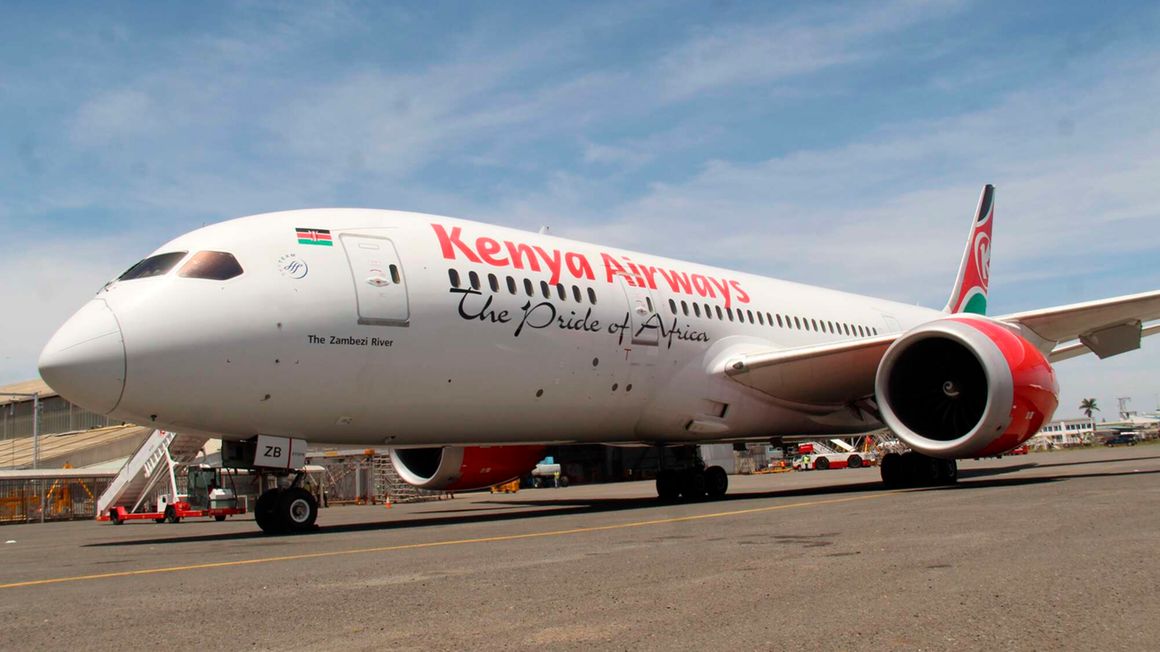
Kenya Airways plane at the Jomo Kenyatta International Airport. FILE PHOTO | LUCY WANJIRU | NMG
Kenya Airways has blamed aircraft manufacturers Boeing and Embraer for plane defects that saw the national carrier make three emergency landings in a month.
The national carrier was forced to make unscheduled landings in London’s Heathrow Airport, Jomo Kenyatta International Airport (JKIA) and Livingston, Zambia in February, according to Flightradar24 – a site that tracks aircraft in real-time.
The airline blamed the plane makers for the defects that triggered the emergency landings, adding that other carriers flying the same model have faced similar troubles.
But Kenya Airways maintained that the quality issues do not affect the immediate safety of flights and that Boeing and Embraer are working on upgrades.
“The technical issues affecting some of our fleet also affect similar fleet types and age worldwide,” Kenya Airways, popularly known by its code-name KQ, said in an email response to the Business Daily on Flightradar24 data.
“The above issues have no relationship with the current industry shortage of parts as all maintenance schedules are being adhered to.”
On February 15, KQ flight 103 from London to Nairobi under Boeing 787-8 (5Y-KZH) suffered a technical hitch after taking off from London Heathrow and the pilot had to turn back to the airport of departure.
Less than a week earlier, the same aircraft B787-8 (5Y-KZH) operating as flight KQ310 to Dubai from Nairobi, diverted back to JKIA shortly after takeoff.
Read: Kenya Airways resumes daily flights to New York
The KQ310, according to FlightRadar24, departed JKIA on February 9 at 18:58, 43 minutes later than the scheduled time, but was diverted to Nairobi, aborting the trip to Dubai.
The Boeing flights were forced to dump fuel, which is the intentional release of aviation petroleum to reduce the aircraft’s landing weight.
Many planes, especially those used for long-haul flights, take off weighing more than their maximum allowed landing weight due to the amount of fuel they carry.
This weight is normally reduced as fuel is consumed during the flight.
But when a flight is cut short the aircraft may still be too heavy to land safely.
In such situations, the pilot may take the rare decision to dump fuel and reduce the aircraft’s weight quickly.
Only certain planes have this capability, and it is done through valves in the aircraft’s wings which allow fuel to be pumped out by a specific amount.
“The air turnback was precautionary due to a slat skew fault. The root cause is corrosion in a rotary gear actuator in the slat system, which affects all 787 of a similar age to the KQ fleet, caused by a design flaw by Boeing that allows moisture to enter the system and cause the said corrosion,” said KQ.
“The fault does not create a safety risk as the system is designed to inhibit the extension of the slat system.”
The national carrier said Boeing is providing parts to replace the corroded slats.
Boeing’s 787 Dreamliner or the wide-body aircraft has faced a series of problems since its launch in 2004.
The Dreamliner model was hailed as a game-changer for the commercial aeroplane industry as its use of lighter materials and new construction methods promised huge savings in fuel and maintenance costs.
On February 23, Boeing temporarily halted deliveries of its 787 Dreamliner jets and will not resume until the Federal Aviation Administration (FAA) is satisfied that it has addressed a fuselage component.
Boeing halted deliveries in 2021 after the FAA raised concerns about its proposed inspection method.
In September 2020, the FAA said it was investigating manufacturing flaws in some 787 jetliners.
KQ, whose strategy hinges on connecting African travellers to the world and vice-versa through its Nairobi hub, operates a fleet of Boeing and Embraer planes.
It relies on the 787 Dreamliner for long-haul flights like European routes and Embraer for shorter African routes.
KQ’s Embraer 190 developed a technical fault at Victoria Falls International Airport on February 8, resulting in close to 100 passengers en-route to Cape Town, South Africa, sleeping over in Livingstone.
This flight normally flies from Nairobi to Cape Town, South Africa and often makes a stopover in Livingstone, Zambia to drop off and pick up passengers.
The national carrier’s management said the Embraer plane to Cape Town suffered an inflight fault that forced the flight to be cancelled.
“An E190 operated the Cape Town flight. Unfortunately, it experienced an inflight fault caused by a failure of a part known as P-ACE that affects the Embraer fleet worldwide. The part has been replaced,” said KQ in the e-mail response.
In January, KQ said it was experiencing flight disruptions due to delays in securing aircraft components required for maintenance.
Read: Taxpayers to take over Sh59.7 billion Kenya Airways loans
It linked the shortages to the Ukraine war crisis, which has significantly crippled the Russian supply chain crucial to global aviation.
KQ cited titanium from Russia as one of the key raw materials used by the aviation industry and is crucial to the maintenance of planes.
“Where parts are not immediately available, the aircraft will be released from maintenance once the required maintenance has been accomplished,” KQ said in the e-mail.
→ gandae@ke.nationmedia.com






No comments :
Post a Comment